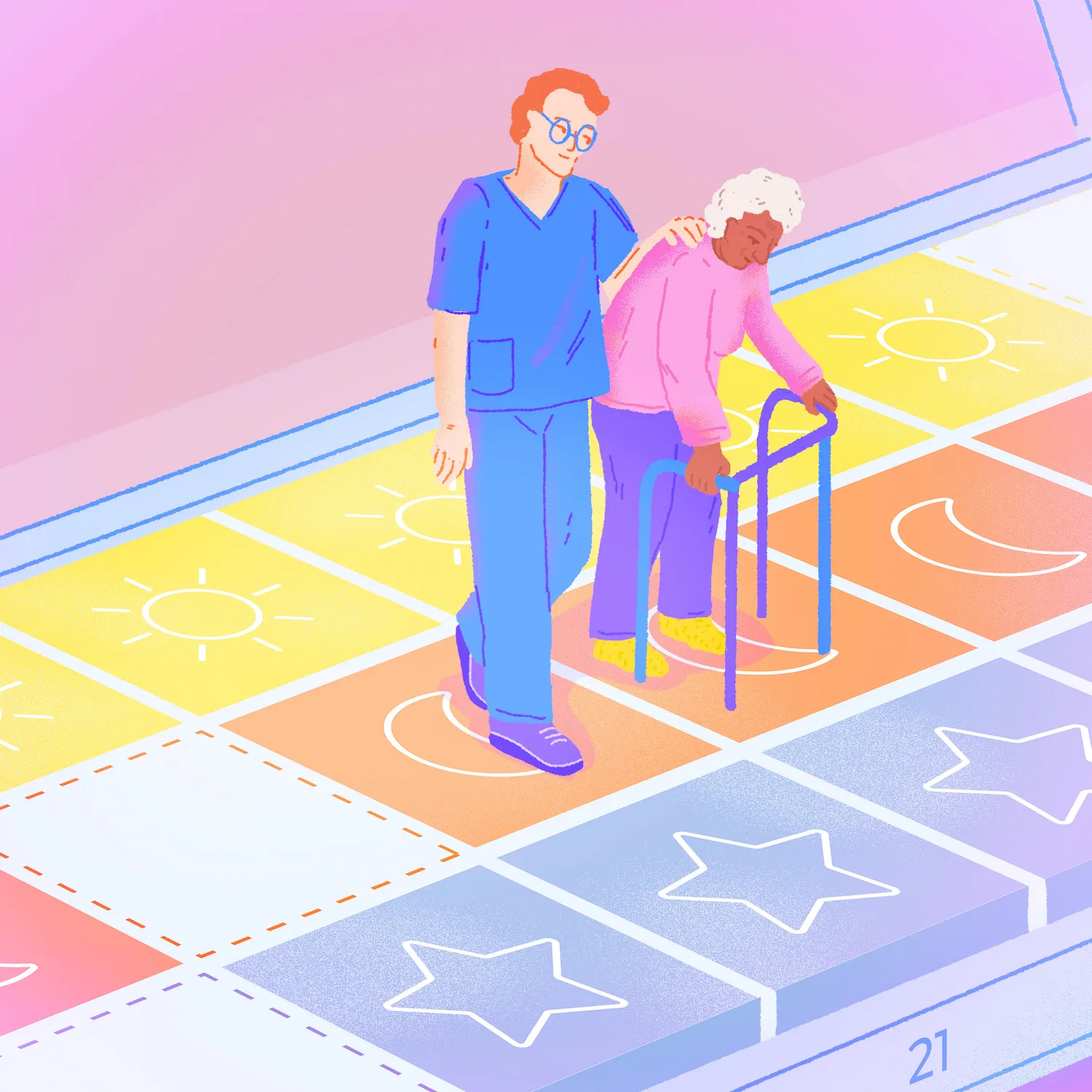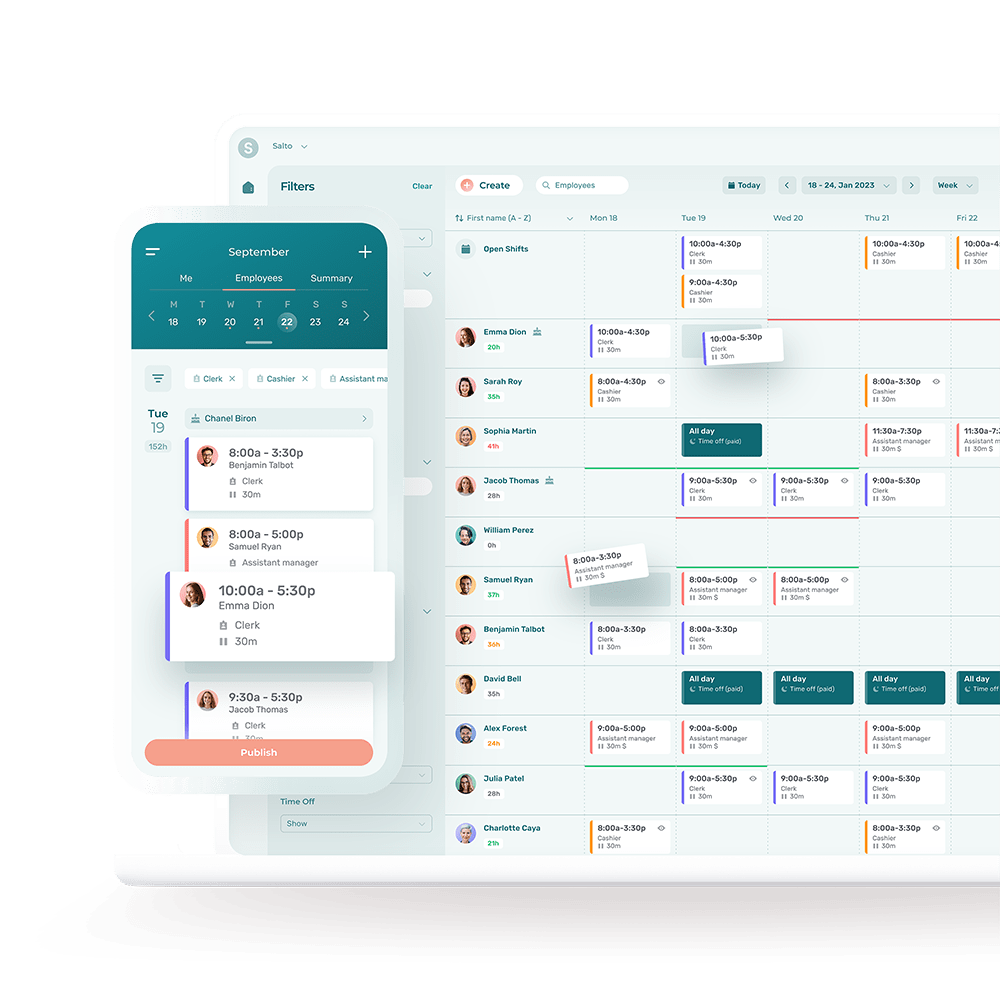If there’s one industry that knows how much of a headache creating and managing schedules can be, it’s the seniors’ residence industry.
A nursing home never stops, so labor needs are very large and varied. Creating the perfect schedule is a constant challenge.
In short, here are some of our tips for creating the best work schedule for your seniors’ residence:
- Master the requirements linked to employment contracts and your residence’s operational needs
- Take employee well-being into consideration when creating schedules
- Equip yourself with scheduling software to make your work easier
In this article, you will discover:
- What to consider when creating your schedules
- Examples of different working hours in senior residences
- The benefits of using scheduling software
What to Bear in Mind When Setting up a Schedule for Your Seniors Residence
Schedules in a nursing home are complex. They must include the staff needed for patient care, housekeeping, kitchens, reception, administrative tasks, and so on.
Let’s take a closer look at each of the aspects to consider when creating a complete work schedule.
Seniors’ Residences Are Never at a Standstill
All residences are open 24 hours a day, 365 days a year. Such hours of operation inevitably bring their lot of difficulties related to manpower, recruitment and employee retention.
The reality is that patients’ needs must be met so as not to endanger their health or affect their well-being. There are also laws that govern patient care and that determine minimum staffing quotas, for instance.
This necessarily influences employees’ work schedules, which can have a significant impact on their personal lives and on the establishment’s labor costs.
That’s why creating and managing schedules is a vital and time-consuming task.
The Operational Needs of Nursing Homes Are Complex
The operational needs of a seniors’ residence are numerous, since it is a living environment. Facilities must:
- Ensure patient health and safety
- Provide adequate health care
- Create a stimulating living environment
- Serve well-balanced meals
- Maintain the cleanliness of the premises
- Etc.
To achieve this, seniors’ residences hire a variety of employees to fulfill many positions: nurses, caretakers, receptionists, maintenance staff, food service attendants, etc.
Since residences are always open, employees are often called upon to work days, evenings and even nights. Laws and regulations also control the minimum number of staff required to ensure patient health and safety at all times.
The labor challenges are therefore very great. Especially when you take into consideration last-minute absences and employee turnover, which can often lead to a growing number of overtime hours for the rest of the team.
Over the next few years, residences will be facing major labor shortage challenges. That’s why it’s essential that they equip themselves with the best tools to get the job done efficiently.
The Many Different Types of Shifts of Nursing Homes
There are many different shifts to fill in a seniors’ residence:
- Day shifts: generally between 8 a.m. and 5 p.m., including several services such as food service, maintenance, patient care, entertainment, etc.
- Evening shifts: generally between 5 p.m. and midnight, often excluding administrative positions.
- Night shifts: usually between midnight and 7 a.m., these shifts are often harder to fill.
- Weekend shifts and holidays: to ensure services are maintained 24/7.
To fill all these shifts, it’s a good idea to ask employees if they have any preferences, and to use part-time employees or students if necessary.
Don’t Neglect Employee Well-Being
Working hours must meet the needs of patients and the residence in general, but they must also suit staff members.
It’s essential that schedules are balanced to allow employees to rest and have a life outside work. For example, employees must be able to request time off easily.
What’s more, allowing employees to swap shifts can be an excellent solution for limiting unjustified absences or no call no shows.
Many of the employees hired by seniors’ residences are also members of a union and have a collective agreement ruling their work. Managers must take great care to respect all the terms and conditions of these agreements.
In 2022 in Canada, there were 2 times as many vacant positions in the healthcare industry as there were in 2019. With an aging population, which therefore means growing needs, and a labor shortage that is just getting worse, seniors’ residences will have to do their best to offer attractive working conditions to their employees.
Working hours are often a major issue for employees. It is therefore crucial to offer flexibility in order to provide staff with a good work-life balance.
Example of Schedules for Seniors’ Residences
Although the operations of a nursing home run 24 hours a day, there are a number of possible working hours.
Let’s take a look at some of them.
Rotating Schedules
Rotating schedules allow employees to work a fixed schedule, but not always at the same time. As a result, they have more flexibility to organize their personal lives, and are not forced to always work the least desirable shifts.
Here are some examples of rotating schedules:
- 7 consecutive working days followed by 7 days off
- Working 1 weekend out of 2
- Working 2 evening shifts, 3 day shifts, 2 night shifts
Flexible Working Hours
Flexible working hours can take many forms, such as:
- Basic schedules and shifts to be filled: the employer schedules a few shifts and publishes open shifts where employees can volunteer to work more hours according to their availability
- Self-scheduling: employees volunteer for the shifts that suit them best. Shifts are allocated according to predefined criteria (seniority, first come, first served, etc.)
- Flexible working hours: shifts vary from week to week according to demand and employee availability
Flexible working hours improve employee satisfaction. The happier employees are at work, the less staff turnover there is, and the higher the quality of services provided to patients.
Fixed Schedules
Fixed schedules offer employees less flexibility, but more stability. With fixed schedules, employees are generally assigned a particular type of shift (day, evening, night, weekend, etc.), and their schedules vary very little.
Using Scheduling Software, an Ally for Seniors’ Residences
The complexity of work schedules in seniors’ residences calls for the use of high-performance tools to improve processes and reduce management time.
Managers of nursing homes should consider using software to modernize their processes, improve employee satisfaction and avoid wasting time.
Creating Schedules More Efficiently
Even though some managers use work schedule templates, scheduling software such as Agendrix considerably reduces the time needed to create schedules. They also reduce errors linked to omissions and changes in availability, and ensure compliance with existing collective agreements.
For example, with scheduling software, managers have a better overview of employee requirements and availability. This makes it easier to maximize the availability of non-healthcare staff to fill certain shifts, and to ensure that qualified employees are in the right place at the right time.
The scheduler also highlights possible scheduling conflicts to limit employee frustration and the multiple changes that errors can cause.
Managers can work with schedule templates to ease their planning. Once the schedule is ready, it takes a single click to share it with staff. Employees can access it directly from the mobile app on their phones. They can make leave requests in the software, and once approved, their availability is updated.
The simplicity and efficiency of scheduling software help to improve employee satisfaction and better monitor the labor costs of different departments.
Making Communication Easier
Scheduling software makes it easy to communicate with employees, thanks to their professional messaging tools with real-time notifications and a news feed.
It also becomes much easier and more efficient to fill open shifts or find replacements thanks to a shifts-to-fill feature. Employees receive a notification when a manager needs to fill a shift, and can volunteer to work. No more time-consuming reminder lists or service disruptions due to staff shortages.
Increasing Employee Satisfaction
Using specialized software allows managers to better respect employees’ preferences and availability. It also ensures that work schedules are not overloaded, and that breaks, rest periods and the various constraints of collective agreements are respected.
As a result, there are far fewer schedule-related errors, which helps to reduce employee frustration. Employees feel more respected and have a better work-life balance.
Employee well-being has a huge impact on the operations of a retirement home. The happier the staff, the lower the turnover rate, and the better the care offered to patients.
Find Out How These Managers Have Transformed Their Scheduling Practices
Several managers of seniors’ residences have taken the plunge and decided to use Agendrix scheduling software.
One of the main reasons they did so was the complexity of managing their schedules and the lack of productivity associated with using the wrong tools.
For example, Joëlle Boulanger, Regional Manager of Groupe Shemie, explains that Agendrix saves her 10 hours per week, which means she can be more present for her employees, in addition to avoiding working weekends.
Using Agendrix has positively changed everything to do with scheduling and payroll, for managers and employees alike.
– Joëlle Bélanger, Regional Manager – Groupe Shemie
Alix, manager of 2 workplaces with 120 employees, used to spend nearly 20 hours a week creating, managing and sharing schedules with employees. With Agendrix, she spends just 5 hours a week carrying out the same tasks.
It has made our work so much easier!
– Alix, Manager – Résidences René-Léosa
This means she’s 4 times faster, allowing her to concentrate on other, even more important tasks.
Agendrix also offers other complementary features to help managers better manage their staff, such as:
- A professional messaging tool
- Time and attendance tracking
- Centralization of employee records
- Automation of timesheets to payroll
- Shift swapping
- Posting open shifts
- Time-off request management
- A news feed for internal communications
- Report creation
- Employee recognition tool
- Vacation banks
Conclusion
Schedules are at the heart of seniors’ residences managers’ concerns. They have a considerable impact on employee morale and on the quality of care and services offered to residents.
As a manager, it’s your responsibility to create balanced schedules that meet the needs of residents while promoting employee satisfaction. To achieve this, use the best tools to simplify your decision-making and ensure that you respect all your requirements.
Many processes can easily be improved and modernized through scheduling software. Try Agendrix today!
How to Create a Schedule for Employees of a Seniors’ Residence?
- Evaluate workforce needs in order to provide the care and services required to maintain a good quality of life for patients
- Determine how often schedules should be planned and shared with employees
- Gather employee availabilities and preferences, as well as the parameters to respect under existing collective agreements (if applicable)
- Assign each shift to be filled to employees according to their role, responsibilities, level of experience, seniority, or any other relevant criteria, all of which can be done with a scheduling software or work schedule templates.
- Ensure compliance with the various laws, regulations and agreements in place
- Share the schedule with employees
- Modify the schedule if necessary and reach out to impacted employees
What Are the Advantages of Using Scheduling Software for Seniors’ Residences?
The benefits of using scheduling software for seniors’ residences include:
- Finding replacements more quickly
- Increasing employee satisfaction
- Reducing employee turnover
- Offering staff a better work-life balance
- Freeing up management time to focus on other important tasks such as employee training
- Avoiding wasted time
- Saving money
- Reducing overtime
- Simplifying communication with employees
- Centralizing information in one place
- Storing employee information in a safe place
- Creating more efficient and modern employee work schedules











